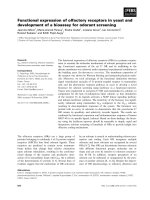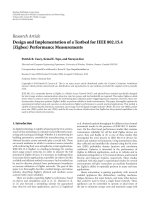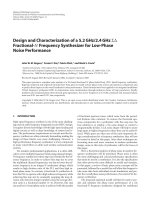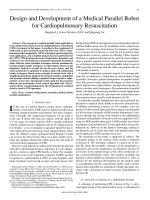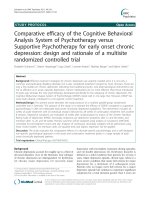Design and development of a bioreactor for ligament tissue engineering
Bạn đang xem bản rút gọn của tài liệu. Xem và tải ngay bản đầy đủ của tài liệu tại đây (2.5 MB, 141 trang )
DESIGN AND DEVELOPMENT OF A BIOREACTOR FOR
LIGAMENT TISSUE ENGINEERING
TEY CHENG HWEE
NATIONAL UNIVERSITY OF SINGAPORE
2007
DESIGN AND DEVELOPMENT OF A BIOREACTOR FOR
LIGAMENT TISSUE ENGINEERING
TEY CHENG HWEE
(M.Sc.), NTU
A THESIS SUBMITTED
FOR THE DEGREE OF MASTER OF SCIENCE
DEPARTMENT OF ORTHOPAEDIC SURGERY
NATIONAL UNIVERSITY OF SINGAPORE
2007
ACKNOWLEDGEMENTS
I am grateful to many people at National University of Singapore for their guidance
and support during this research. First and foremost, I would like to thank my advisor,
Assoc. Prof. James Goh for providing me an opportunity to pursue research in this
interesting area and his counsel throughout and being extremely understanding in his
supervisory role.
Special thanks to Dr. Fan Hongbin (research fellow), Mr Yeow Chen Hua (PhD
student) and Ms Wang Yue (Master student) for lending me so much help in my
cellular investigations. Their generosity in imparting their knowledge is greatly
appreciated. I am very grateful for the efforts of Dr. Ge Zigang (post-doctoral), Dr.
Liu Haifeng (research fellow), Mr Moe Kyaw (ex-research assistant), Mr. Sambit
Sahoo (PhD student) and Mr Zheng Ye (PhD student) in their assistance in silk
scaffold fabrication and bioreactor design. I very much appreciate the efforts of Ms
Julee Chan, senior lab officer in histology, for providing valuable information while
performing histological analysis of the samples. Her experiences and dedication to
work make my work easier and simpler and provided me with adequate background
to analyse the data.
I thank the administrative staff, Grace Ng and Jennifer Chong Sue Wee from
Department of Orthopaedic Surgery in prompt processing of the purchasing work for
fabrication of bioreactor and ordering of other experimental materials. Special thanks
to my colleagues at National University of Singapore Tissue Engineering Program
iv
Laboratory at Defence Science Organisation (Kent Ridge branch) and Clinical
Research Centre for providing support and technical assistance.
v
TABLE OF CONTENTS
ACKNOWLEDGEMENTS
LIST OF TABLES
iii
viii
LIST OF FIGURES
x
SUMMARY
xiii
CHAPTER 1 INTRODUCTION
1
1.1
ANATOMY AND FUNCTION OF LIGAMENT
1
1.2
ANTERIOR CRUCIATE LIGAMENT
4
1.2.1
4
ACL Injury
1.2.2 METHODS OF ACL RECONSTRUCTION
7
1.3
HYPOTHESIS & OBJECTIVES
8
1.4
THESIS ORGANISATION
9
CHAPTER 2: LITERATURE SURVEY
2.1
2.2
10
LIGAMENT TISSUE ENGINEERING
10
2.1.1
Cells
11
2.1.2
Scaffolds
12
2.1.3 Bioreactor
17
TYPES OF CELL-SEEDING SYSTEM
21
2.2.1
Straining Bioreactors
21
2.2.1.1 Uniaxial Cell Stretcher
21
2.2.1.2 Advanced Bioreactor
23
2.2.1.3 Overview of Straining Bioreactors for ACL growth 25
2.2.2
Perfusion Bioreactors
26
2.2.2.1 The Spinner Flask Bioreactor
26
vi
2.2.2.2 The Rotating Wall Bioreactor
28
2.2.2.3 The Flow Perfusion Bioreactor
29
CHAPTER 3: DESIGN AND FABRICATION OF BIAXIAL MECHANICAL
STIMULATION AND PERFUSION BIOREACTOR
32
3.1
DESIGN CRITERIA
32
3.2
MATERIAL SELECTION
33
3.3
OVERALL BIOREACTOR DESIGN
34
3.3.1 The Actuating System
37
3.3.2 The Control System
40
CHAPTER 4: MATERIALS AND METHODS
43
4.1
CELL ISOLATION AND CULTURE
43
4.2
SCAFFOLD PREPARATION
44
4.3
BIOREACTOR SETUP
45
4.4
CELL SEEDING
47
4.5
TISSUE CHARACTERISATION
48
4.5.1 Cell Viability
48
4.5.2 Biomechanical Testing
49
CHAPTER 5: RESULTS AND DISCUSSION
5.1
51
RESULTS
52
5.1.1 Experimental conditions
52
5.1.2 Preliminary Studies
53
5.1.2.1 Cell Viability
53
5.1.2.2 Mechanical Stimulation
54
5.1.3 Follow-up Studies
5.1.3.1 Cell Viabililty
59
59
vii
5.1.3.2 Mechanical Stimulation
60
CHAPTER 6: CONCLUSIONS & RECOMMENDATIONS
68
APPENDIX A: MACHINE DRAWINGS
72
A.1
BASE
72
A.2
CHAMBER
75
A.3
MISCELLANEOUS
91
APPENDIX B: STRESS-STRAIN CURVES FOR PRELIMINARY STUDIES
102
APPENDIX C: STRESS-STRAIN CURVES FOR FOLLOW-UP STUDIES
106
REFERENCES
112
viii
LIST OF TABLES
Table 1:
Overview of ACL related bioreactors
26
Table 2:
Comparison of Cell-seeding Systems in osteoblastic cell culture study
31
Table 3:
The linear extensions and torsional angles associated with each
experiment in non-static culture
53
Table 4:
Mechanical propertiesa of tubular porous scaffolds
56
Table 5:
Mechanical propertiesa of tubular porous scaffolds
62
ix
LIST OF FIGURES
Figure 1.1.
Alignment of fibroblasts in ligament tissue [2]
2
Figure 1.2.
Relationship between a collagen bundle and fibroblasts. The collagen
bundle is comprised of individual collagen fibrils that tightly surround
the cells [6].
Figure 1.3.
2
Stress–strain behaviour of ligament. The graph displays the threestaged behaviour of ligament (toe region, linear region, and yield
region).
3
Figure 1.4a.
Normal Knee Anatomy [11]
6
Figure 1.4b.
Different degree of ACL injuries [11]
6
Figure 2.1.
Fundamental components of ligament tissue engineering.
Figure 2.2.
Schematic of the cell stretcher. The components are as follows: A,
10
stepping motor; B, lead screw; C, TiN coated yoke; D, 150-mm culture
dish; E, poly-ether-etherketone (PEEK) slider; and F, Ultem 1000 base
plate. The stepping motor is driven from a programmable motor drive.
The motion profile is entered into the drive via a microterminal
interface (not shown). The cell stretch membrane is placed in between
the PEEK slider components and clamped with polytetrafluorethylene
(PTFE) clamps [105].
Figure 2.3.
22
Functioning bioreactor system including (a) peristaltic pump, (b)
environmental gas chamber and (c) the two bioreactors containing 24
vessels [108].
25
Figure 2.4.
Spinner Flask [109]
27
Figure 2.5.
Rotating Wall bioreactor [111]
28
x
Figure 2.6.
Flow Perfusion Bioreactor [115]
30
Figure 3.1.
Design of one reactor vessel of bioreactor
35
Figure 3.2.
Top view of bioreactor operating inside a standard cell culture
incubator at 37°C and 5% CO2. The bioreactor consists of 4 parallel
chambers. The sample can be stressed biaxially during incubation.
Figure 3.3.
Translation deformation provided by gear and screw whereby both are
tightened by a mini-screw (as shown by the vertical gadget).
Figure 3.4.
38
Original length of scaffold indicated by the arrow after scaffold is
fixed to the two anchor fixtures besides the arrow.
Figure 3.5.
36
39
Bioreactor with cell-seeded scaffolds under biaxial cyclic mechanial
stimulation in culture medium.
39
Figure 3.6.
User interfaces of four cyclic/non-cyclic modes.
41/42
Figure 4.1.
Sketch of scaffold dimensions.
Figure 4.2.
Setup in incubator (top), data acquisition and control system (bottom)
45
46
Figure 5.1.
Comparison of bMSCs proliferation on silk scaffolds under different
growth conditions.
Figure 5.2.
54
Examples of the stress–strain behaviour of cell-seeded scaffold
cultured under static and non-static conditions. Each plot notes the toe
region (1), and linear region (2).
Figure 5.3.
Mechanical parameters of cell-seeded scaffolds measured using Instron
for static and non-static cultures.
Figure 5.4.
55
57-58
Comparison of bMSCs proliferation on silk scaffolds under different
growth conditions.
59
xi
Figure 5.5.
Examples of the stress–strain behaviour of cell-seeded scaffold
cultured under static and non-static conditions. Each plot notes the toe
region (1), and linear region (2).
Figure 5.6.
61
Mechanical parameters of cell-seeded scaffolds measured using Instron
for static and non-static cultures.
63-66
xii
Summary
Mechanical signals applied in-vitro to cell-scaffold construct may induce the
formation of ligament-like structure having in-vivo functional properties, has been
proposed as a method to develop tissue-engineered ligaments. To explore this
hypothesis, a novel bioreactor was designed to study the in vitro effect of biaxial
cyclic mechanical stimulation on the adhesion, differentiation and proliferation of
rabbit bone marrow stromal cells (rBMSCs) loaded on silk scaffolds housed in four
reactor vessels, in conjunction with enhanced environmental and perfusion fluidic
control under sterile conditions. The cell seeding and perfusion system is made of
polycarbonate and is translucent. The whole system consists of four cell seeding
chambers that can be incorporated into the perfusion system whereby mechanical
stimulation is provided by eight stepper motors connected to the bioreactor. The cell
culture medium continuously circulates through a closed-loop system. We thus
developed a cell seeding device for static and dynamic seeding of rBMSCs onto a
tubular silk scaffold and a closed-loop perfused bioreactor for long-term mechanical
conditioning.
Adjusting the perfusion flow rate, different mechanical strains (resolution of <0.1 mm
for translational strain and <1° for rotational strain) and motor rotation frequency
could be applied to the developing tissue over prolonged periods of operation. The
device can be sterilised partly by steam autoclaving and wiping with 70% ethanol.
Preliminary studies include four sets of experiments of seven days each, were carried
out at constant temperature (37 +/− 0.2°C), pH (7.4 +/− 0.02), and pO2 (20 +/− 0.5%),
under either 30° or 60° rotational and either 6 mm or 12 mm translational
xiii
deformations at 0.1 Hz. Compared to unstrained samples, the system supported cell
spreading and growth on the silk fibre matrices based on MTT assay characterisation.
The introduction of biaxial cyclic mechanical stimulation to the fibrin gel coated and
freeze-dried with silk sponge onto knitted silk scaffold resulted in a significant
increase in the ultimate tensile strength, an increase in ultimate strain, and an increase
in the length of the toe region in these constructs over knitted scaffolds. Based on the
findings
of
this
study,
applying
suitable
cyclic
mechanical
stimulation
(translation/rotational strains) was found to have a promising effect on tissue
engineering of the ACL.
xiv
CHAPTER 1: INTRODUCTION
1.1
ANATOMY AND FUNCTION OF LIGAMENT
Ligaments are bands of dense, highly ordered fibrous connective tissue connecting
bone to bone across a joint. The function of the ligament is to maintain the
mechanical stability of the joints in the muscuskeletal system, to guide the joint
motion, and to prevent excessive motion.
Ligaments contain a hierarchical structure with increasing levels of organisation
including collagen molecules, fibrils, fibril bundles, and fascicles that are organised
along the long axis of the tissue. Ligaments are collagenous tissue with their primary
building unit being the tropocollagen molecule [1]. This basic unit consists of three
alphahelix chains coiled together in a right-handed twist. Tropocollagen molecules
Tropocollagen molecules gather to form a collagen microfibril and organise
periodically into long cross-striated fibrils that are arranged into bundles to form
collagen fibers, which are interspersed with spindle-shaped fibroblasts that are
aligned along the fibers in the longitudinal direction of the ligaments (refer to Figure
1.1 below) [2]. The collagen fibrils display a periodic change in direction called a
crimp pattern. The collagen fibers are then organised into collagen bundles of 1-20
µm in diameter, which are further grouped into larger bundles called fascicles of 100250 µm in diameter to form the ligament. These fascicles are arranged in a dense
helical pattern near the ligament-bone junction and parallel to the longitudinal axis of
the ligament in the internal region [3]. The fascicles contain collagen fibrils,
1
proteoglycans, and elastin. In addition, the fascicles are surrounded by a sheath of
vascularised and transparent recticular membrane to form fibers [4,5] (Figure 1.2).
Figure 1.1. Alignment of fibroblasts in ligament tissue [2]
Figure 1.2. Relationship between a collagen bundle and fibroblasts. The collagen
bundle is comprised of individual collagen fibrils that tightly surround the cells [6].
Due to the arrangement of their components, ligaments display three stages of
behaviour when placed under strain (Figure 1.3). First, there is an area where the
ligament exhibits a low amount of stress per unit strain (low slope) labelled the nonlinear or toe region. When force is first applied to the tissue it is transferred to the
2
collagen fibrils resulting in lateral contraction of fibrils and the straightening of the
crimp pattern. Following this area is the linear region, which displays an increase in
slope. Once the crimp pattern is straightened, the force is directly translated into
collagen molecular strain [7,8]. The yield and failure region is the last area; it displays
a decrease in slope and represents the defibrillation of the ligament [8]. In this area,
the collagen fibers in the ligament fail by defibrillation causing a decrease in slope
and tissue failure [8-10].
Figure 1.3. Stress–strain behaviour of ligament. The graph displays the three-staged
behaviour of ligament (toe region, linear region, and yield region).
Other fascicles are non-parallel fibers of varying lengths to allow different areas of
ligament to be loaded at different times by varying degrees [10,11]. Collagen fiber
bundles are arranged in the direction of functional need and act in conjunction with
elastic and reticular fibers along with ground substance, which is a matrix of
glycosaminoglycans (GAG) and tissue fluid, to give ligaments their mechanical
characteristics, thus imparting “fiber reinforced composite”-like properties to the
tissues. In unloaded or unstressed ligaments, collagen fibers take on a sinusoidal
3
pattern. This pattern is referred to as a “crimp” pattern and is believed to be created
by the cross-linking or binding of collagen fibers with elastic and reticular fibers,
which straightens under load.
The major constitutes of ligaments are proteins such as collagen types I, III and V and
elastin, glycoproteins, protein polysaccharides, glycolipids, proteoglycans, water and
cells [12]. The collagen matrix provides the tensile strength of ligaments. The
ligament consists of ~75% (dry weight) (90% is type I and 10% is type III) collagen
and <1% (dry weight) elastin, a fibrillar protein that affects the mechanical properties,
with the proteoglycans and glycoproteins making up the rest [13]. Water makes up
about 60-80% of wet weight of ligaments with functions in viscous behaviour,
lubrication & fascicular sliding and transport of nutrients and waste.
1.2
ANTERIOR CRUCIATE LIGAMENT
1.2.1
ACL Injury
A knee contains four major supporting ligaments of the knee, one on either side
(lateral collateral ligament and medial collateral ligament), and two interior ligaments
(anterior cruciate ligament (ACL) and posterior cruciate ligament), which help
control stabilisation and kinematics of the knee joint. The ACL is one of the most
commonly ruptured ligament in the human knee joint [14]. Annually, more than
200,000 patients are diagnosed with ACL disruptions [15,16] and approximately
150,000 ACL surgeries are performed in the United States annually [17]. Men and
women who are athletically active experience the majority of ligament tears,
4
particularly tearing of the ACL of the knee, which is the main stabiliser of the knee
for athletic pivotal activities.
A normal knee joint ACL is shown in Figure 1.4a, which is a band of regularly
oriented, dense connective tissue that connects the femur and tibia. The complex
anatomy of the human ACL is dependent upon the orientation, construct, and biology
between molecules and cells. Its primary role is to restraint anterior displacement of
the tibia in relation to the femur. ACL injuries occur during sports and exercise
activity when the femur and tibia twist in opposite directions under full body weight,
causing a tear (Figure 1.4b). This happens when an athlete changes or twist direction
rapidly, slows down when running falls awkwardly, or lands from a jump. ACL
injuries disrupt the delicate balance of knee structures and may affect knee functional
activities. Left untreated, as the torn will generally not heal, the joint loses its
stability during pivoting activity and causes further destruction of the articular surface
and cause tearing in the meniscal cartilage over time and even osteoarthritis [18].
The ACL has poor intrinsic ability to heal itself because it is surrounded by the
synovial membrane and lacks significant vascularity [19] and often results in a
ligament architecture that is significantly different from uninjured tissue. As a result
of this impaired structure, the healed ligament is neither as robust nor as capable of
performing normal functions. Therefore, surgical reconstruction of ACL is
recommended and it is desirable to stabilise the knee by reconstructing a torn anterior
cruciate ligament.
5
Figure 1.4a. Normal Knee Anatomy [11] Figure 1.4b. Different degree of ACL
injuries [11]
The ACL has a unique helical collagen fiber organisation and structure to perform its
stabilising functions. The mode of attachment to bone and the need for the knee joint
to rotate ~140° (extension/flexion) results in a 90° twist of the ACL major fiber
bundles and the peripheral fiber bundles, hence developing a helical organisation. In
full extension, individual fibers of the ACL are attached anterior-posterior and
posterior-anterior from the tibia to the femur in the sagittal plane of the knee. This
helical geometry allows the individual ACL fiber bundles, during knee joint flexing,
to develop a flexion axis about which each individual fiber bundle or fascicle twists
thereby remaining isometric in length. During flexion, fiber bundle isometry allows
the ACL to equally distribute load to all fiber bundles, maximising its strength. It is
this unique structure-function relationship that allows the ACL to sustain high loading
through all degrees of knee joint extension and flexion. Therefore, it is hypothesised
that a tissue engineered prosthesis exposed to physiologically relevant translational
and torsional strains will develop a structure suitable for function following
implantation in vivo. The lack of torsional strains (e.g., only translation) during in
6
vitro ligament engineering would fail to support the development of a helical
structure capable of effectively distributing load throughout the tissue placing the
prosthesis at a higher risk for rupture. While torsional strain alone acts to translate
individual fibers organised in a helical geometry, translational strains are needed to
control fiber pitch angle and mimic anterior draw loads typically stabilised by the
ACL. Thus, the combination of both translational and torsional strains is needed for
ACL tissue engineering.
1.2.2
Methods of ACL Reconstruction
Rupture of the anterior cruciate ligament (ACL) remains one of the most common
sports-related injuries. Current treatments, although fairly successful, do not provide
the optimum therapy. Choices of tissue for the reconstruction are varied, but two
categories are currently utilised most frequently: natural replacements (allografts,
autografts) or synthetic materials. In other words, these treatments typically rely on
donor tissues obtained either from the patient or from another source. Both autografts
and allografts possess good initial mechanical strength and promote cell proliferation
and new tissue growth. However, they suffer from a number of disadvantages.
Allografts pose the risk of graft rejection and re-rupture; and infection transmission
and synovitis caused by adverse immune response. Autografts reconstruction on the
other hand, require substitution with a sacrificial skeletal muscle from another part of
the body that does not affect the basic functions of the donor site reconstruction
which raises the issue of insufficient supply.
The disadvantage of synthetic
replacement is in the material limitation in achieving the desired mechanical strength
7
and surface properties of the natural ACL [10,19]. Nonetheless, a major factor in the
failure of all of these treatments is the biomechanical mismatch in the native tissue
and the graft.
A successful tissue engineered graft must possess mechanical properties similar to the
ACL. Despite the great development shown in surgical treatment of ACL and
consequent knee stability to date, none of these procedures is to the point where it has
either fully restore or reproduce this complicated ligament to its pre-injury state,
which has challenged research on tissue engineering strategy in recent years to
reconstitute its function when lost by replacing with a functional neotissue
(engineering tissue) with similar mechanical and functional characteristics. The aim
in tissue engineering of ligaments is to provide an implant that will parallel the native
ACL in both its biologic properties and mechanical durability. Hence, there is a
clinical need for improved ACL tissue replacements due to donor site morbidity,
lengthy rehabilitation periods, and increased risk of tendonitis.
1.3 HYPOTHESIS & OBJECTIVES
In this study, it was hypothesised that combining appropriate mechanical stimulation
with perfusion flow in cell-seeded scaffolds will cause an increase in toe region
length, strain at failure, and maximum load when compared to static culture. In other
words, mechanical signals applied in-vitro to cell-scaffold construct will induce the
formation of ligament-like structure having in-vivo functional properties.
8
Since tissue formation on scaffold will conform eventually to the structure and shape
similar to that of the scaffold, there is a need to develop a mechanical cum perfusion
system that can support film-like polymeric scaffold for ligament tissue engineering.
Hence, the objectives of this study are:
(i)
To design and develop a bi-axial cyclic loading and low shear stress perfusion
bioreactor system for ligament tissue engineering;
(ii)
To optimise the effect of varying mechanical stimulation on the adhesion,
differentiation and proliferation of bone marrow stromal cells loaded on silk
scaffold; and
(iii)
To develop a functional ligament-like structure suitable for tissue repair.
1.4 THESIS ORGANISATION
The present chapter describes the background and objectives of this study. To begin
with, a brief summary of relevant literature survey on ACL and existing bioreactors
are discussed in Chapter 2. Following which, Chapter 3 describes the design and
fabrication of an improved perfusion bioreactor incorporating biaxial mechanical
stimulation. Chapter 4 will discuss the materials and methods of this experiment. In
Chapter 5, the outcome results of the experiments and discussions are described.
Finally, the conclusions and recommendations for the future development are
provided in Chapter 6.
9
CHAPTER 2: LITERATURE SURVEY
2.1
LIGAMENT TISSUE ENGINEERING
Tissue engineering represents a new approach to creating functional and viable tissue
from autologous cells for surgical application. This approach can potentially address
tissue and organ failure by providing functional tissue constructs grown in vitro that
have a capacity to continue to develop in vivo and integrate with the host tissues. In
addition, engineered tissues can serve as physiologically relevant models for
quantitative in vitro studies of biological mechanisms inherent in tissue development.
The challenge in this research area is to find the best combination of scaffold
material, cells, seeding- and culture procedures. The properties of the tissueengineered ligament can be influenced by mechanical and biochemical conditioning
during culture (Figure 2.1).
Figure 2.1. Fundamental components of ligament tissue engineering.
10
2.1.1
Cells
The emerging field of tissue engineering has shown to be a promising alternative in
using cell transplantation as a strategy to achieve tissue repair and regeneration for a
variety of therapeutic needs. One approach involves use of three-dimensional cell(collagen or polymer) grafts for in vivo implantation. In other words, the creation of
an autologous implant requires that donor tissue is harvested and dissociated into
individual cells or small groups of cells. These cells may then be attached to or
encapsulated and cultured into a support matrix such as a proper polymer scaffold
which is ultimately transplanted to the patient at the desired site of the functioning
tissue to restore lost tissue function. The appropriate cell type for ligamental tissue
engineering must show enhanced proliferation and production of an appropriate
extracellular matrix and must be able to survive in an intraarticular environment in
the patient’s knee. The use of various cell lines is described, such as ACL and medial
collateral ligament fibroblasts, bone marrow stromal cells (BMSCs), and tenocytes.
ACL fibroblasts are cells specialised in producing all ligament constituents and
maintaining the ligament tissue in the appropriate conformation. However, it is well
known that the anterior cruciate ligament has poor healing capacities in contrast to
other ligaments, such as the medial collateral ligament. This deficient repair could be
due to several intrinsic properties of the cells, as responsivity to growth factors
[20,21], adhesion strength [22–24], proliferation, and migration rate were reported to
be lower compared with other cell types [22–29]. Bellincampi et al. demonstrated the
survival of skin fibroblasts in an intraarticular environment to be superior over ACL
11
fibroblasts [30], making this cell source also a potential donor cell for our engineered
ligament.
Generally, bone marrow and specific organs are the optimal cell sources for tissue
engineering. BMSCs have been extensively studied for bone, cartilage and tendon
regeneration [30-35], while fibroblasts from ACL have been investigated by several
groups [36-39] working on in vitro ACL analogue engineering.
Recent findings of the potential of adult stem cells to lead to a variety of
differentiated cell types [40,41] suggest that this cell type will provide important new
options to forming biologically and functionally relevant ligament tissues in vitro.
However, this goal can only be achieved if suitable environmental signals, both
mechanical and biochemical, can be provided to the cells to direct their differentiation
path. Importantly, none of the known biochemical regulatory factors has been shown
to promote adult stem cell differentiation into ligament-like cells in vitro.
2.1.2 Scaffolds
In order to successfully replace and regenerate new ACL tissue, several criteria define
the ideal material for a cell transplantation matrix. The material must be
biocompatible, in the sense that it does not provoke a connective tissue response
which will impair the function of the new tissue; yet it must subsequently degrade
over time that does not cause stress shielding or rupture of the new tissue and yield to
the progress of native tissue ingrowth; easily and reproducibly processable into a
12
